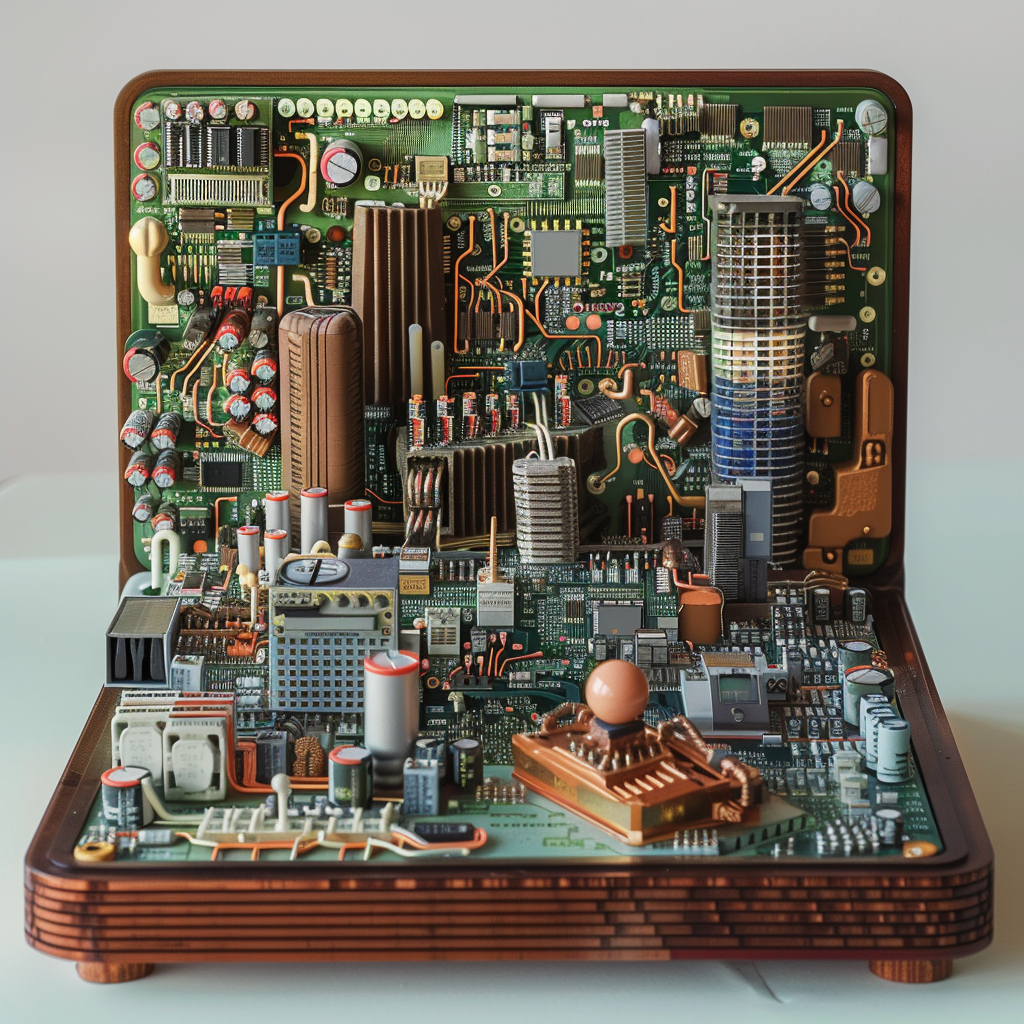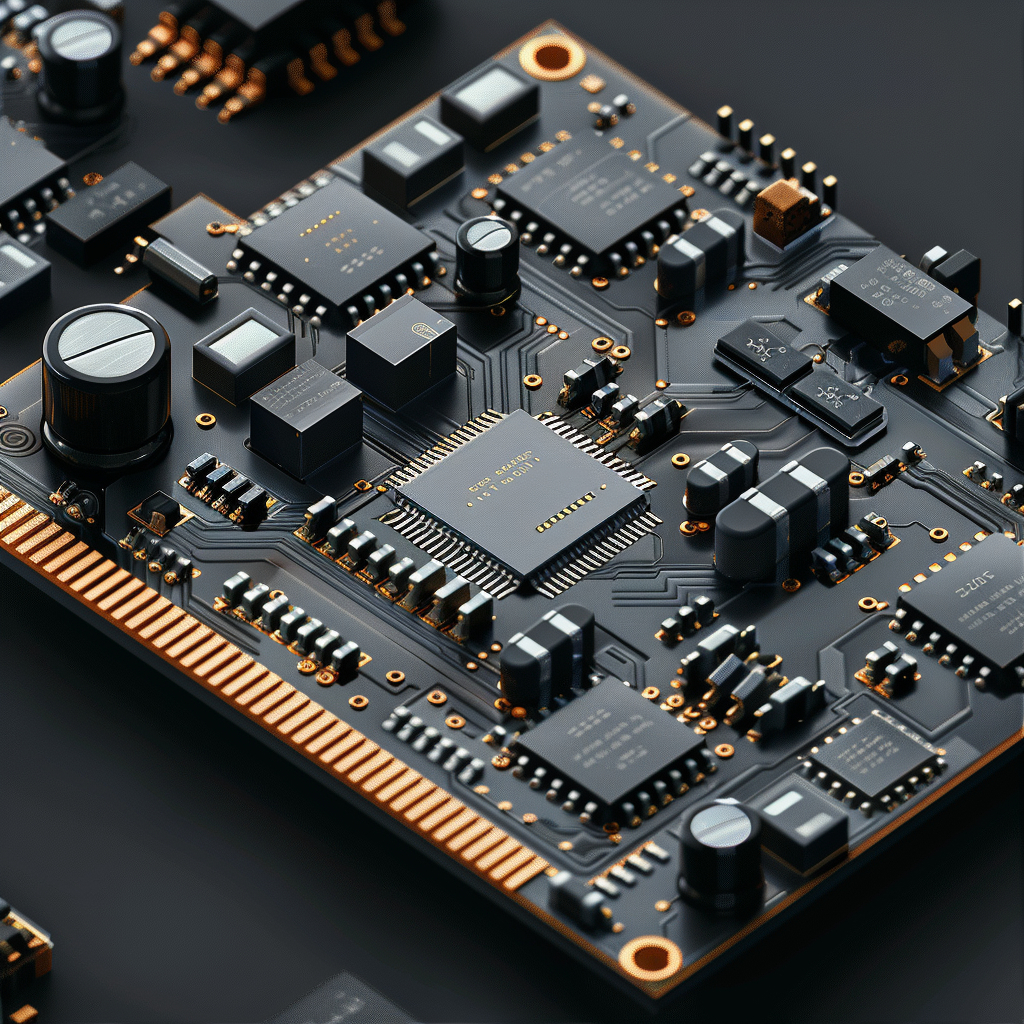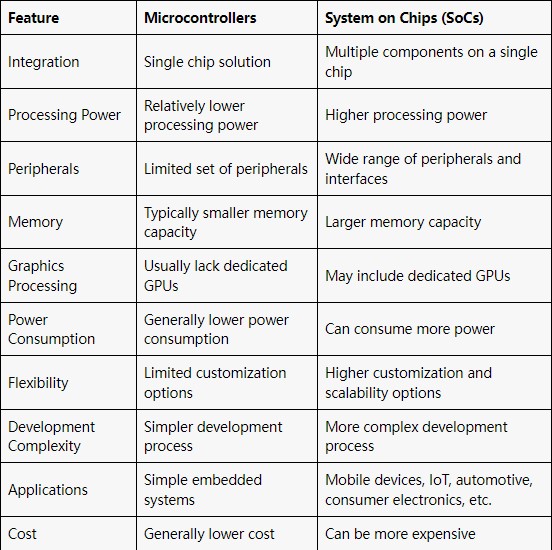Time: 2024-03-05 16:29:36View:
Microcontrollers are small, self-contained computer systems integrated into a single chip. They consist of a central processing unit (CPU), memory, and various input/output peripherals. Microcontrollers are designed to perform specific tasks and are commonly used in embedded systems, IoT devices, and consumer electronics. They are cost-effective, low-power devices that provide real-time responsiveness. However, they have limited processing power, memory capacity, and lack advanced peripherals compared to more complex systems. Microcontrollers are widely used in applications where simplicity, low cost, and power efficiency are essential.
System on Chips (SoCs) are advanced electronic devices that integrate multiple components and subsystems onto a single chip. They function as complete computer systems on a chip, containing not only a central processing unit (CPU) but also various other elements like memory, input/output (I/O) peripherals, graphics processing units (GPUs), network interfaces, and more. SoCs are engineered to deliver a high level of functionality and performance in a compact form factor.
SoCs stand out due to their integration of multiple components. This integration allows SoCs to offer significant benefits in terms of size, power efficiency, and cost. Instead of utilizing separate chips for different functions, such as CPU, memory, and peripherals, all these components are consolidated into a single chip, resulting in a more efficient and streamlined design.
SoCs find applications in various fields, including mobile devices, smartphones, tablets, automotive systems, and smart appliances. In the realm of mobile devices, SoCs act as the primary computing engine, housing essential components like the CPU, GPU, memory, and more. They enable the execution of complex tasks, multitasking capabilities, and support for advanced features such as high-resolution displays, multimedia processing, and wireless connectivity.
The benefits of SoCs are plentiful. They offer higher processing power compared to microcontrollers, thanks to their powerful CPU cores capable of executing complex tasks and running resource-intensive applications. Additionally, SoCs provide increased memory capacity, enabling the storage of larger amounts of data and software. They also come equipped with advanced peripherals and interfaces, such as high-speed data buses, USB ports, Ethernet controllers, and audio/video interfaces.
However, there are certain limitations associated with SoCs. One of the primary drawbacks is their higher cost in comparison to microcontrollers. The integration of multiple components onto a single chip necessitates more intricate manufacturing processes, which can lead to elevated production expenses. Additionally, due to their enhanced processing power and increased functionality, SoCs tend to consume more power than microcontrollers. This can be a concern, particularly in battery-powered devices where power efficiency is of utmost importance.
From a design and development perspective, SoCs are more complex when compared to microcontrollers. The integration of multiple components and the requirement for efficient communication between them pose challenges for system designers. Moreover, developing software and drivers for SoCs can be more intricate due to the larger number of components and the need to optimize performance and power consumption.
In conclusion, System on Chips (SoCs) are highly integrated electronic devices that combine multiple components and subsystems onto a single chip. They offer significant advantages in terms of functionality, performance, and size. SoCs are widely used in various applications, and their integration of components allows for higher processing power, advanced peripherals, and improved connectivity. However, they also come with higher costs, increased power consumption, and added complexity in design and development compared to microcontrollers.

System on Chips (SoCs) encompass a range of features that contribute to their versatility and high-performance capabilities. These features make SoCs suitable for various applications, from mobile devices to automotive systems. Let's delve into some of the key features of SoCs:
1. Integration of Components: SoCs are designed to integrate numerous components onto a single chip. This integration includes a central processing unit (CPU), memory (both volatile and non-volatile), input/output (I/O) peripherals, graphics processing units (GPUs), network interfaces, and more. By combining these components, SoCs offer a compact and efficient solution for complex computing tasks.
2. Powerful CPU Cores: SoCs are equipped with powerful CPU cores capable of executing complex instructions and running resource-intensive applications. These CPU cores can be based on various architectures, such as ARM, x86, or RISC-V, and often incorporate multiple cores or even heterogeneous multi-core configurations. The presence of powerful CPU cores enables SoCs to handle demanding computational tasks efficiently.
3. Memory Subsystems: SoCs incorporate various types of memory subsystems, including random-access memory (RAM), read-only memory (ROM), and flash memory. These memory subsystems enable the storage and retrieval of data and instructions required for seamless operation. SoCs often provide ample memory capacity to accommodate large software applications and data sets.
4. Advanced Peripherals and Interfaces: SoCs feature a wide array of peripherals and interfaces to facilitate connectivity and interaction with external devices. These may include high-speed data buses, universal serial bus (USB) ports, Ethernet controllers, audio/video interfaces, and wireless connectivity options like Wi-Fi, Bluetooth, or cellular modems. The availability of advanced peripherals and interfaces enhances the functionality and connectivity capabilities of SoCs.
5. Graphics Processing: Many SoCs are equipped with dedicated graphics processing units (GPUs) or integrated graphics cores. These components provide hardware acceleration for graphics rendering, enabling the smooth execution of graphical user interfaces (GUIs), multimedia processing, and gaming applications. The inclusion of graphics processing capabilities enhances the visual experience and performance of devices powered by SoCs.
6. Low-Power Capabilities: While SoCs offer high performance, they also incorporate power management features to optimize energy consumption. This is particularly crucial for battery-powered devices such as smartphones and wearables. SoCs employ power management techniques like clock gating, dynamic voltage scaling, and power domains to minimize power usage during idle or low-demand periods.
7. Security Features: SoCs incorporate security features to protect sensitive data and ensure the integrity of the system. These features may include secure boot mechanisms, hardware-based encryption/decryption, secure key storage, and trusted execution environments (TEEs). The integration of security features in SoCs helps safeguard against unauthorized access, tampering, and data breaches.
8. Scalability and Customization: SoCs offer scalability, allowing manufacturers to choose different configurations and components based on their specific application requirements. This flexibility enables customization, where SoCs can be tailored to meet the needs of different devices and industries.
System on Chips (SoCs) offer numerous advantages that make them popular in a wide range of applications. However, they also have certain drawbacks that need to be considered. Let's examine the advantages and disadvantages of SoCs:
Advantages:
Integration and Compactness: SoCs integrate multiple components onto a single chip, including a CPU, memory, peripherals, and interfaces. This integration results in a compact and space-efficient solution. SoCs eliminate the need for separate chips for each component, reducing the overall size and complexity of the electronic system.
Performance and Efficiency: SoCs often incorporate powerful CPU cores, enabling high-performance computing. They are capable of executing complex tasks and running resource-intensive applications efficiently. The integration of advanced peripherals and interfaces enhances system efficiency and responsiveness.
Cost-Effectiveness: Despite their advanced capabilities, SoCs can be cost-effective compared to alternative solutions. By integrating multiple components into a single chip, the overall manufacturing and assembly costs can be reduced. Additionally, the elimination of external components reduces the bill of materials (BOM) cost.
Power Optimization: SoCs employ power management techniques to optimize energy consumption. They can dynamically adjust clock frequencies, voltage levels, and power domains to minimize power usage during idle or low-demand periods. This power optimization is particularly important in battery-powered devices, extending battery life.
Customization and Scalability: SoCs offer flexibility for customization and scalability. Manufacturers can choose different configurations and components based on their specific application requirements. SoCs can be tailored to meet the needs of different devices, allowing for optimized performance and functionality.
Disadvantages:
Complexity in Design: Developing SoCs involves intricate design processes. The integration of multiple components and subsystems onto a single chip requires careful consideration of system architecture, interconnectivity, and power management. Designing and fabricating SoCs require specialized knowledge and expertise, which can increase development time and cost.
Cost: While SoCs can be cost-effective compared to alternative solutions, they can still be relatively expensive due to the complexity of their design and manufacturing processes. The integration of numerous components onto a single chip often requires advanced fabrication techniques, which can result in higher production costs.
Power Consumption: Despite power optimization features, SoCs generally consume more power compared to simpler solutions, such as microcontrollers. The inclusion of powerful CPU cores, graphics processing units, and advanced peripherals contributes to increased power requirements. This can be a concern in battery-powered devices, where power efficiency is crucial.
Limited Flexibility: SoCs, by their nature, offer a fixed set of components and interfaces integrated onto a single chip. While they provide customization options, these are limited to the available configurations offered by the chip manufacturer. This lack of flexibility may not suit applications that require extensive hardware modification or specialized components.
Development Complexity: Developing software and drivers for SoCs can be more complex compared to simpler systems. The integration of multiple components and the need for optimized performance and power consumption require careful software development and testing. This complexity can increase the development time and effort required.
In conclusion, System on Chips (SoCs) offer advantages such as integration and compactness, high performance, cost-effectiveness, power optimization, and customization. However, they also have drawbacks, including design complexity, cost, increased power consumption, limited flexibility, and development complexity. These advantages and disadvantages should be considered when selecting SoCs for specific applications, weighing the benefits against the associated challenges.

System on Chips (SoCs) find applications in a wide range of industries and devices due to their versatility, integration capabilities, and high-performance features. Let's explore some of the key applications of SoCs:
1. Mobile Devices: SoCs are extensively used in smartphones, tablets, and wearable devices. They serve as the main computing engine, providing high-performance processing, graphics capabilities, and connectivity features. SoCs enable seamless multitasking, efficient power management, and support for advanced mobile applications.
2. Internet of Things (IoT): SoCs play a crucial role in IoT devices, which require embedded computing capabilities. SoCs power smart home appliances, security systems, industrial sensors, and wearable fitness trackers, among others. They enable efficient communication, data processing, and connectivity in IoT ecosystems.
3. Automotive Systems: SoCs are widely deployed in automotive applications, ranging from infotainment systems and instrument clusters to advanced driver assistance systems (ADAS) and autonomous driving. SoCs provide the computing power and real-time responsiveness required for in-vehicle entertainment, navigation, connectivity, and safety features.
4. Consumer Electronics: SoCs are found in various consumer electronics, including smart TVs, set-top boxes, gaming consoles, and digital cameras. They enable high-definition video processing, graphics rendering, and connectivity options, enhancing the user experience and enabling advanced multimedia features.
5. Industrial Automation: SoCs are utilized in industrial automation and control systems. They power programmable logic controllers (PLCs), motor control units, and industrial robotics. SoCs provide the necessary processing power, real-time control capabilities, and communication interfaces for efficient and reliable industrial automation.
6. Medical Devices: SoCs play a vital role in medical devices, such as patient monitoring systems, portable diagnostic devices, and medical imaging equipment. They enable real-time data processing, connectivity for remote monitoring, and high-resolution imaging capabilities.
7. Aerospace and Defense: SoCs are utilized in aerospace and defense applications, including unmanned aerial vehicles (UAVs), satellite systems, radar systems, and communication equipment. They provide the necessary computational power, communication capabilities, and data processing for mission-critical operations.
8. Smart Grids and Energy Management: SoCs are employed in smart grid systems and energy management solutions. They enable efficient control, monitoring, and optimization of power generation, transmission, and distribution. SoCs facilitate real-time data processing, communication with smart meters, and intelligent energy management algorithms.
9. Embedded Systems: SoCs are extensively used in various embedded systems, such as industrial control systems, home automation systems, vending machines, and point-of-sale terminals. They provide the necessary computing power, connectivity, and control capabilities for these specialized applications.
10. Scientific and Research Applications: SoCs find applications in scientific research, simulations, and data analysis. They are used in high-performance computing clusters, supercomputers, and data centers, enabling advanced simulations, modeling, and scientific calculations.
The versatility of SoCs allows them to be employed in numerous other applications, including gaming consoles, virtual reality (VR) devices, agricultural systems, smart cities, and more. Their integration capabilities, high performance, and customization options make SoCs a key technology for enabling advanced functionality and connectivity in various industries and devices.
Here's a table comparing some of the key differences between microcontrollers and System on Chips (SoCs):

It's important to note that these are general characteristics, and there can be variations within each category depending on specific microcontrollers and SoCs. The selection between microcontrollers and SoCs depends on the specific application requirements, desired functionality, performance needs, and cost considerations.